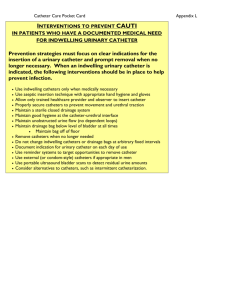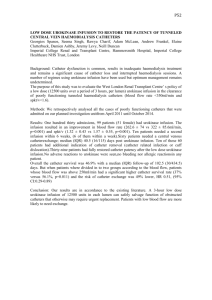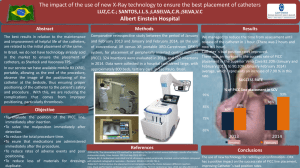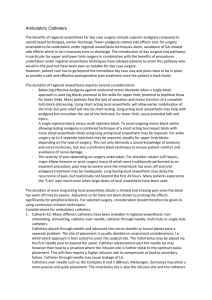Guidelines For Managing Ambulatory Continuous Peripheral Nerve Catheters (CPNB)
advertisement
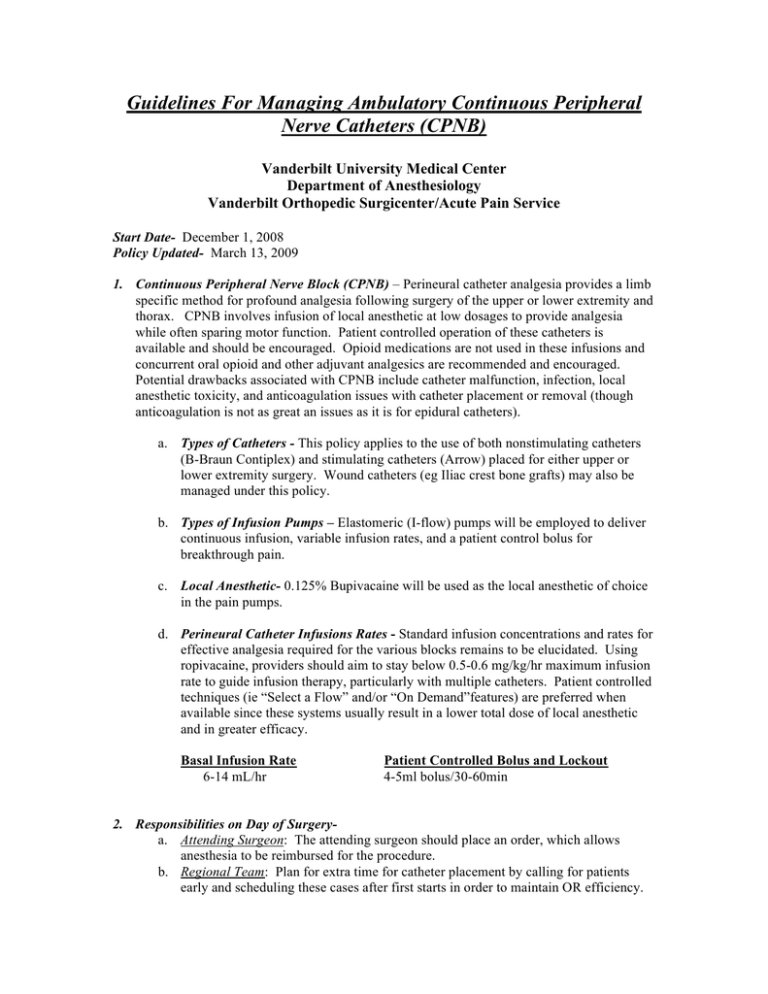
Guidelines For Managing Ambulatory Continuous Peripheral Nerve Catheters (CPNB) Vanderbilt University Medical Center Department of Anesthesiology Vanderbilt Orthopedic Surgicenter/Acute Pain Service Start Date- December 1, 2008 Policy Updated- March 13, 2009 1. Continuous Peripheral Nerve Block (CPNB) – Perineural catheter analgesia provides a limb specific method for profound analgesia following surgery of the upper or lower extremity and thorax. CPNB involves infusion of local anesthetic at low dosages to provide analgesia while often sparing motor function. Patient controlled operation of these catheters is available and should be encouraged. Opioid medications are not used in these infusions and concurrent oral opioid and other adjuvant analgesics are recommended and encouraged. Potential drawbacks associated with CPNB include catheter malfunction, infection, local anesthetic toxicity, and anticoagulation issues with catheter placement or removal (though anticoagulation is not as great an issues as it is for epidural catheters). a. Types of Catheters - This policy applies to the use of both nonstimulating catheters (B-Braun Contiplex) and stimulating catheters (Arrow) placed for either upper or lower extremity surgery. Wound catheters (eg Iliac crest bone grafts) may also be managed under this policy. b. Types of Infusion Pumps – Elastomeric (I-flow) pumps will be employed to deliver continuous infusion, variable infusion rates, and a patient control bolus for breakthrough pain. c. Local Anesthetic- 0.125% Bupivacaine will be used as the local anesthetic of choice in the pain pumps. d. Perineural Catheter Infusions Rates - Standard infusion concentrations and rates for effective analgesia required for the various blocks remains to be elucidated. Using ropivacaine, providers should aim to stay below 0.5-0.6 mg/kg/hr maximum infusion rate to guide infusion therapy, particularly with multiple catheters. Patient controlled techniques (ie “Select a Flow” and/or “On Demand”features) are preferred when available since these systems usually result in a lower total dose of local anesthetic and in greater efficacy. Basal Infusion Rate 6-14 mL/hr Patient Controlled Bolus and Lockout 4-5ml bolus/30-60min 2. Responsibilities on Day of Surgerya. Attending Surgeon: The attending surgeon should place an order, which allows anesthesia to be reimbursed for the procedure. b. Regional Team: Plan for extra time for catheter placement by calling for patients early and scheduling these cases after first starts in order to maintain OR efficiency. After informed consent, appropriate CPNBs will be placed most commonly before surgery in the Block Area. Catheters will be placed with strict sterile technique, sterilely dressed, and secured. Mastisol and/or dermabond to dry skin with the LockIt system are recommended with catheters, especially with interscalene catheters which have the highest rate of dislodgement. Rule out intravascular catheters by an appropriate bolus through the catheter at time of placement or prior to discharge. c. Attending Anesthesiologist: The attending anesthesiologist will ensure that the box entitled “Continuous” (eg “Continuous” Femoral Nerve Block) is checked in Gas Chart, which will initiate the proper reimbursement process. d. Anesthesiology Resident: 1. NSC: The resident will document the Procedure Note for the CPNB in Star Panel, using the appropriate CPNB template. The I-Flow Pump Serial # and Lot #, as well as the Contiplex Catheter/Needle Serial # and Lot#, will be given to the OR Circulator for proper documentation in VPIMS. Postoperatively, the patient will be assessed for adequate analgesia and the dressing should be reassessed and reinforced if necessary. The resident will fill the pump using sterile technique and initiate the infusion in the recovery room. The resident will review pump function with the patient and available family members prior to discharge. The “Patient Instruction Brochure for Ambulatory CPNBs” will be completed with anesthesiologists’ names (resident and attending) and the “Outpatient Pain Service” (OPS) pager number (835-0721) for any questions and concerns. The resident will ensure OPS coverage when they are unavailable, either with another regional resident or attending. Finally, the resident will add the patient name, phone number, catheter type, day of surgery, and surgery to the OPS white board in the Anesthesia Office (NSC) and to the REDcap database. 2. Main Hospital: The resident will document the Procedure Note for the CPNB in Star Panel, using the appropriate CPNB template, and write a WizOrder for the infusion using the ambulatory pump. In addition, pumps will be checked out by patient name from the Core Area for appropriate billing and brought to Pharmacy for filling. Postoperatively, the patient will be assessed for adequate analgesia and the dressing should be reassessed and reinforced if necessary. The resident will review pump function with the patient and available family members prior to discharge. For CPNBs placed in the Main Hospital, the APS will continue to follow these catheters until catheter removal; prior to discharge from the Main Hospital, patients will be given the “Patient Instruction Brochure for Ambulatory CPNBs” including the anesthesiologists’ names (resident and attending) and the APS pager number (835-5701) for any questions and concerns. Finally, patients should remain on the APS Census on WizOrder until the catheter is removed and remain in the Redcap Database as well. Careful handoffs between members of the APS Team will ensure that patients have continuous APS coverage between teams. e. Pharmacy: At the Main OR, the OR Pharmacy will fill the pump sterilely using standard protocols and notify anesthesia when available. f. NSC OR Circulating Nurse: Intraoperatively, the Circulating OR Nurse will include the I-Flow Pump Serial # and Lot #, as well as the Contiplex Catheter/Needle Serial # and Lot# in the VPIMS- Intraoperative Nursing Section- Implants. 3. Duration of CPNB Infusions- CPNB infusions should be limited to less than 96 hours, except for extenuating circumstances on a case by case basis. I-flow pumps cannot be refilled; if additional duration is needed after a pump runs out, an additional pump will need to be utilized. 4. Breakthrough Pain – If patients complain of persistent pain > 5/10 despite continuous local anesthetic infusion, consider managing the patient with oral multimodal therapy (see below) and/or evaluating the catheter at the surgicenter or hospital. Upon physician evaluation, several options for troubleshooting are available. Arrow stimulating catheters may be stimulated to confirm proper position after resolution of the block. The practitioner should bolus the catheter with 10-20 mL with 1.5% mepivacaine and epinephrine 1:400,000 or equivalent. If the patient experiences improvement in their pain, the practitioner should increase the background infusion usually in 2-5 mL increments. If no improvement is experienced, the catheter should be considered incorrectly positioned and be removed. (N.B. Significant pain deep to the catheter sight has been associated with a deep catheter infection and should be part of the differential diagnosis, particularly for catheters of > 72hrs duration.) 5. Multimodal Therapy: While advanced regional anesthesia techniques may significantly diminish acute pain, patients undergoing extensive surgery, particularly those who are opioid-tolerant, may require multimodal analgesia in addition to CPNBs. Consider adding the following analgesics as appropriate: a. Short –acting Opioids: Most patients will be given short-acting oral opioids, most commonly hydrocodone or oxycodone, 5-10mg tablets, usually in a preparation which includes 325-500mg of acetaminophen. With a daily acetaminophen maximum of 4000 mg, a patient may take up to 8 tablets of the short-acting combination meds per day safely. b. NSAID’s: After discussing with the surgeon, adding NSAID of your choice (eg Meloxicam 7.5-15mg po qd) will diminish the opiate requirement. Avoid traditional NSAID’s in patients with a history of gastritis, renal dysfunction, and/or bleeding diathesis. Celebrex (100-200mg bid), a COX-2 inhibitor, offers some advantages including less risk of gastritis, no platelet inhibition, and reduced central sensitization. c. Long-acting Opioids: Challenging acute pain patients may require a short course of long-acting agents, such as oxycontin 10-20mg po bid or methadone 5-10mg po tid. Initiate therapy with the lowest possible dosing with the intent to discontinue therapy after the catheter is discontinued. d. Other: Co-administration of other agents, including clonidine 0.1-0.2mg po bid, as well as anticonvulsants (eg gabapentin 300-600mg po tid) can be effective in reducing opioid requirements, particularly in opioid-tolerant patients, in the acute pain setting. 6. Catheters and anticoagulation – Deep peripheral nerve catheters (eg lumbar plexus or paravertebral catheters) should not be placed or removed during periods of significant anticoagulation. Our guideline for low molecular weight heparin is not to place or remove deep catheters within 12 hours of the last dose. 7. Responsibility for Follow-up of Patients – a. Nashville Surgery Center Patients: The Orthopedic Surgicenter Team will provide care for all OPS patients. The Regional resident(s) will review with the attending anesthesiologist any existing ambulatory CPNBs and maintain the REDcap database. The REDcap database and the OPS White Board will allow the various anesthesiologists to effectively follow patients and note any changes made. Daily evaluation of each patient will most commonly be telephonic but can be in person at the surgicenter depending on the needs of the patient. Clinical care will be documented in Star Panel on a daily basis using the APS Encounter Note template. The Attending Anesthesiologist will discuss the care with the resident and attest each of the Star Panel notes. If patients need to be evaluated in person after hours, the patient will be instructed to come to the PACU or Emergency Room of the Main Hospital for evaluation there by the OPS team. (We anticipate that the need to provide in-person after hours care to be very infrequent; if the after hours care is simply to pull a catheter, this duty may be delegated to the VUH Call resident or APS team if mutually agreeable.) b. APS Patients: - The APS Team will provide care for all APS patients. The Regional resident(s) will review with the attending anesthesiologist any existing ambulatory CPNBs and maintain the APS Census and the REDcap database. The REDcap database will allow the various anesthesiologists to effectively follow patients and note any changes made. Daily evaluation of each patient will most commonly be telephonic but can be in person at the hospital depending on the needs of the patient. Clinical care will be documented in Star Panel on a daily basis using the APS Encounter template. The Attending Anesthesiologist will discuss the care with the resident and attest each of the Star Panel notes. If patients need to be evaluated in person after hours, the patient will be instructed to come to the PACU or Emergency Room of the Main Hospital for evaluation there by the APS team. (We anticipate that the need to provide in-person after hours care to be very infrequent; if the after hours care is simply to pull a catheter, this duty may be delegated to the VUH Call resident if mutually agreeable.) 8. Review of Program – Review of procedures and patient outcomes will be reviewed monthly by the Medical Director of the Orthopedic Surgicenter and the Acute Pain Service Director, and reported at the respective POD meetings. Revisions to this policy will be completed as necessary to ensure the highest degree of patient safety, satisfaction, and outcomes. Questions and concerns regarding the policy can be addressed to: Randall J. Malchow, MD Associate Professor, Anesthesiology Medical Director, Vanderbilt Orthopedic Surgicenter Rajnish Gupta, MD Assistant Professor, Anesthesiology Associate Director, Vanderbilt Adult Acute Pain Service
